|
|
|

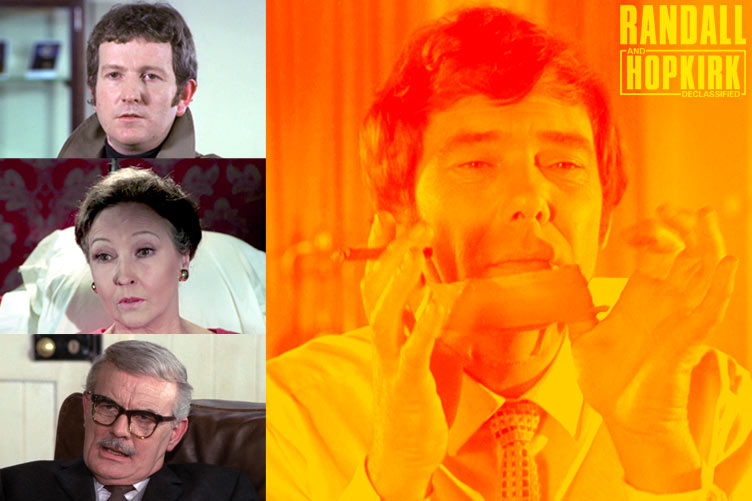
|
Images © ITV Studios, 1969 /
Composition @ Alan Hayes © 2024 |
|
Writer: Tony Williamson
Director: Jeremy Summers |
|
ORIGINAL ITC SYNOPSIS |
|
In the vicious world
of big business Jeff Randall is definitely not
himself!
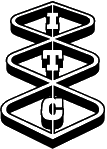
The day when Jeff Randall
can no longer see or hear his ghostly partner,
Marty Hopkirk, is the day both have been
dreading for a long time, and now it seems to
have arrived.
The only thing is, Jeff
doesn't appear to be bothered by it. It's as
though he has forgotten all about Marty. So,
thinking it might be due to overwork, Marty goes
to a psychiatric session presided over by the
celebrated Sir Oliver Norenton and takes
advantage of a patient's hypnotic state to give
Jeff's address to Sir Oliver.
The work Jeff has been
engaged on is that of finding out who has been
leaking information from the Towler Corporation
and using it to play the Stock Market. The
police, in the form of Inspector Large, are also
in on it because one of the directors was
murdered after arranging an appointment with
Jeff.
Before Sir Oliver arrives
(on a visit that's to no avail, anyway), Marty
hears Jeff ring up Holly, the Personnel Manager
of the company - to arrange an appointment.
Later Holly is found dead, but Jeff swears
blindly to Large that he never 'phoned him.
This is too much. Using
another of Sir Oliver's patients, Mrs. Trotter,
Marty tries again to jog Jeff's memory with a
message but Jeff gets rid of her quickly because
he is hiding someone he appears to be in league
with, Jarvis.
Then, after planning with
Jarvis, Jeff gains entrance to the apartment of
the Managing Director, Hepple, and kills him,
despite Marty's effort to stop him.
It's only back at Jeff's
apartment that the, by now, astounded Marty sees
what's going on. Jeff is not Jeff at all. A
cleverly applied face mask comes off to reveal a
man named Hinch.
Large is now openly
suspicious, but Hinch's excuse is that Hepple
gave him the case so why should he want to kill
him? At this Jean jumps to the alert. She
recalls it was Laker, the General Manager, who
gave him the case, and not Hepple.
Following this up, both she
and Marty find that Laker's house holds the
answers to many questions, the least of which
being the whereabouts of the real Jeff. Sir
Oliver's hypnotic assistance is eventually put
to good use, though...
|
|
|
PRODUCTION & ARCHIVE |
Production
Code:
RH/DCW/4018
Filming Dates: Mar-Apr 1969
Production Completed: Early July 1969
Recording Format: 35mm Colour Film
Archive Holding: 35mm Colour Film |
|
UK REGIONAL PREMIERES |
|
Anglia: Sun 15 Nov 1970, 3.00pm (M*)
ATV: Fri 7 Nov 1969, 7.30pm (M)
Border: Fri 27 Feb 1970, 7.30pm (M)
Channel: Fri 12 Dec 1969, 7.05pm (M)
Grampian: Wed 8 Apr 1970, 8.00pm (M)
Granada: Fri 7 Nov 1969, 7.30pm (M)
Harlech: Sun 26 Oct 1969, 3.45pm (M)
LWT: Sun 23 Nov 1969,
7.25pm
Scottish:
Sat 5 Feb 1972, 11.20pm
Southern: Sun 30 Nov 1969,
7.25pm (M)
Tyne Tees: Sun 30 Aug 1970,
9.05pm
Ulster: Fri 7 Nov 1969, 7.30pm (M)
Westward: Fri 12 Dec 1969, 7.05pm (M)
Yorkshire: Fri 7 Nov 1969, 7.30pm (M) |
(M) =
Transmitted in Monochrome/Black and White
(M*) = Transmitted in B/W due to ITV Colour
Strike |
|
CHARACTERS & CAST |
|
Jeff
Randall
Marty Hopkirk
Jean Hopkirk
Inspector Large
Sir Oliver Norenton
Jarvis
James Laker
Mrs. Emily Trotter
Hepple
Sir Timothy Grange
Diana
Holly
Tilvers
Tully
Hinch |
Mike Pratt
Kenneth Cope
Annette Andrι
Ivor Dean
Clifford Evans
Keith Barron
Reginald Marsh
Bessie Love
Basil Dignam
Peter Stephens
Rosemary Donnelly
Philip James
David Stoll
John Garvin
David Downer |
|
STAND-INS |
Jeff Randall
Marty Hopkirk
Jean Hopkirk |
Harry Fielder
Dougie Lockyer
Tina Simmons |
|
STUNT
DOUBLES |
|
Jeff Randall |
Rocky Taylor |
|
BLU-RAY
RESTORATION |
|
35mm Negative /
Magnetic soundtrack |
|
EPISODE SPECIAL FEATURES |
|
Production footage
(mute, 01:03), Photo Gallery |
|
ORIGINAL SOUNDTRACK |
|
Music for this
episode was recycled from stock and therefore no
release of a soundtrack of When Did You Start To Stop Seeing Things?
has been issued. |
|
|
PRODUCTION CREDITS |
|
An ITC Production
Writer Tony Williamson
Series Theme / Musical Director Edwin Astley
Series Creator / Executive Story Consultant Dennis
Spooner
Creative Consultant - Cyril Frankel
Producer Monty Berman
Director Jeremy Summers |
|
Production
Supervisor Ronald Liles
Director of Photography Brian Elvin
Art Director Charles Bishop
Post Production Philip Aizlewood
Editor Lee Doig
Production Manager Malcolm Christopher
2nd Unit Director Jack Lowin
2nd Unit Cameraman Gerald Moss
Sound Recordists Denis Porter and Dennis
Whitlock
Sound Editor Peter Lennard
Music Editor Deveril Goodman
Casting John Owen
Set Dresser Roger Christian
Construction Manager Bill Greene
Camera Operator Frank Drake
Assistant Director Michael Meighan
Continuity Sally Ball
Production Buyer Peter Dunlop
Make-Up Elizabeth Romanoff
Hairdresser Henry Montsash
Costume Supervisor Laura Nightingale
Scenic Artist A. J. Van Montagu
Stunt Co-ordinator Frank Maher
Sound Effects Cinesound
Titles Chambers + Partners
Made on
Location and at Associated British Elstree
Studios, London, England
© Copyright
ITC-INCORPORATED TELEVISION COMPANY LTD MCMLXVIII |
|
|
WHEN DID YOU
START TO STOP SEEING THINGS? REVIEW |
|
Tony Williamson's script for
When Did You Start to Stop Seeing Things? takes
the series' central conceit, that Jeff Randall can see
and interact with his dead partner, and gives it a
180° twist: what could have happened to suddenly
change that situation? Marty is on his own as he tries
to solve the mystery, with the subplot of Laker's
financial misconduct at the Towler Corporation being a
McGuffin that takes up little of the episode's time or
the viewer's attention. And that's fine and dandy. The
undoubted highlight of the episode is Mike Pratt's
performance as the counterfeit Jeff, which is well
observed and nuanced - Jeff but not Jeff. Anyone in any doubt
about Mike Pratt's abilities as an actor should be
pointed towards this episode in which he is thoroughly
convincing as each of the Jeff Randalls and he
established
is a clear distinction between them. The
aspect of Hinch's impersonation that goes unaddressed
- and maybe it's for the good of the episode - is that
we never hear his real voice, as he has no dialogue
when unmasked and played by David Downer. The only
disappointing aspect of this story is the rubber mask
as the audience have been asked to suspend their
disbelief throughout and then at the end it is highly
unconvincing in the last shot of the dead Hinch. One
wonders if a better last shot would have been of Mike
Pratt playing the corpse, as it had already been
established earlier in the episode (when Marty sees
Hinch take the mask off) that this was not the real
Jeff. All round, though, a fabulous and strong episode
from the pen of the redoubtable Tony Williamson that
gave Mike Pratt an opportunity to show what he was
truly capable of. Extra brownie points for Keith
Barron as a chillingly cold villain, and it's always a
joy to see Clifford Evans and he clearly enjoyed his
turn in Randall and Hopkirk (Deceased). |
|
|
WHEN DID YOU
START TO STOP SEEING THINGS? DECLASSIFIED |
-
Pre-Titles Teaser... Tully drives
his orange sports car into the underground car park,
finds a vacant space and parks up. He has come to
meet Jeff Randall, but he can see no sign of the
private detective. He checks his watch - Randall
should be here by now. He gets out of the car and
calls out, "Mr. Randall!" - he receives no reply. He
calls again and then sounds the horn of his car. As
he does this, someone approaches, but it is not Jeff
Randall. The man that Tully sees before him is a
dark-haired, cold-faced man in a khaki trench coat.
Tully asks if Randall has sent him, but the stranger
is silent. He reaches into his inside coat pocket
and withdraws from it a revolver, complete with
silencer. Tully looks on aghast and makes a run for
it. Coldly, the stranger aims and pulls the trigger.
In the far distance, Tully falls to the ground,
dead. "That's right, Tully. Mr. Randall sent me,"
intones the killer.
-
Production
Brief...
When Did You Start To Stop Seeing Things? was the
eighteenth episode to
go before the cameras. It was the Tony Williamson's
sixth episode as scriptwriter and the third to
be directed by Jeremy Summers.
-
Roger Christian returned as set
dresser for this episode, a role that he would also
fill for the final six episodes of the series,
starting with
The
House on Haunted Hill.
-
Exact filming
dates for this episode are unknown, but it is
believed to have been filmed in March and April
1969.
-
A fully edited version of this
episode was completed by early July 1969.
-
On Location...
When Did You Start To Stop Seeing Things? is an episode
set predominantly in urban locales, with only
High Canons (previously seen in
It's Supposed to Be Thicker Than Water)
bucking the trend. Otherwise, the action takes place
in London's Fitzrovia, Holborn, Knightsbridge and
Marylebone areas, with stop offs in Randall and
Hopkirk (Deceased)'s familiar
stamping grounds of St. John's Wood, Harrow and the
car park beneath ABPC Elstree
Studios. More details in
Locations: When Did You Start To Stop Seeing Things?.
-
Haunting Melodies... Edwin Astley was not asked to compose any
new music cues for When Did You Start To Stop Seeing Things?,
with its score coming entirely from stock. One piece
of library music was used, a Chappell cue composed by John
Barry - Mood Three - and this was used to
accompany the scene where Sir Oliver, under
hypnotic instruction from Marty, behaves like a
secret agent. A tiny snatch of this theme was later
used in
Could You Recognise the Man Again?
-
Seeing Things...
When Did You Start To Stop Seeing Things? received its first UK
broadcast on Sunday 26th October 1969 at 3.45pm when
it aired in monochrome in the HTV
ITV region.
-
It was first shown in colour on
ITV on Sunday 23rd November
1969 at 7.25pm in the London Weekend Television region.
-
Trivia...
Psychiatrist Sir Oliver
Norenton shares offices at 42 Harley Street with Sir
Digby Fowling, a neurosurgeon, M.J. Bartell, an ear,
nose and throat specialist, and Sir Lattimer Glade,
a maxillofacial surgeon.
-
The abstract artwork seen
hanging behind Hepple's desk in his penthouse suite
had first been seen as one of Lord Manford's art
treasures in The Avengers: From Venus with Love
(1967), for which it was specially created. The
design originally filled the complete canvas, but
for reasons unknown was whitewashed in part for
Randall and Hopkirk (Deceased) to create
restrict the active area of the painting to the
shape of a human body. Declassified's Art
Critique: they blinking ruined it!
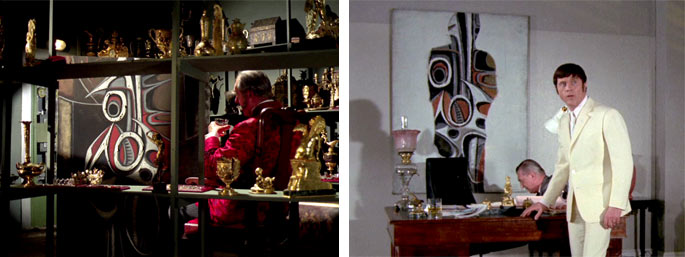 |
|
|
Image ©
StudioCanal, 1967 |
Images ©
ITV Studios, 1969 |
|
|
|
|
|
-
Only You, Jeff?
This one's more a case of "Not even Jeff!" but Marty
is fortunate in being able to communicate with
patients of Sir Oliver Norenton, namely Tilvers,
Mrs. Trotter and Sir Timothy Grange, when he has put
them under hypnosis. Later, Marty manages to communicate
and suggest actions to Norenton when Sir Oliver is
himself in a trance.
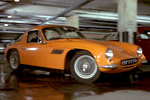 |
1969 TVR Vixen S2
Registration PHP 999G
Driven by Tully |
Also appeared in:
Randall and Hopkirk (Deceased) -
'Money to Burn'
Department S - 'The Soup of the Day' |
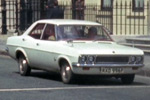 |
1968 Vauxhall
Victor FD 2000
Registration RXD 996F
Driven by Jeff Randall |
Also appeared
in:
Randall and Hopkirk (Deceased) -
used extensively throughout the series
Department S - 'The Last Train to
Redbridge', 'The Man from X' |
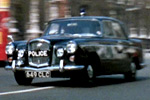 |
1962 Wolseley 6/110
MkI
Registration 649 CLC |
Also appeared
in:
Man in a Suitcase - 'The
Sitting Pigeon', 'The Whisper', 'Why They Killed
Nolan', 'Jigsaw Man', Property of a Gentleman' |
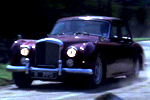 |
1959 Bentley S2
Continental
Registration
11 PPO
Driven by
Sir Oliver Norenton |
Also appeared
in:
Randall and Hopkirk (Deceased) -
'The Man from Nowhere', 'Just
for the Record' (with fake HAL 14 plates)
Department S - used
extensively in the series with fake European plates (Jason
King's car) |
|
Images © ITV
Studios, 1969 |
-
Seen It All
Before? Familiar sets were used for the study,
hallway and cellar of The Manor House, Milton Vale
- home of James Laker - with subtle changes compared to how they had
appeared in previous episodes.
-
The lift area of Hepple's
penthouse suite had featured previously in
Never Trust a Ghost.
-
The name Lattimer (later used more
prominently in
The
House on Haunted Hill) appears here on a
Harley Street door sign as the forename of a
maxillofacial surgeon: Sir Lattimer Glade.
-
Cock-ups... The first cock-up in When Did You
Start to Stop Seeing Things? appears at 8
minutes and 7 seconds into the episode when Marty
approaches the door of several Harley Street
pracititioners. As he nears the door, we see a brass
letterbox with a series of vertically arranged brass
nameplates above it. The camera cuts to Marty
studying them and then we cut to a shot of the
nameplates... only they are now wooden nameplates,
three vertical and with another to their right,
against plain concrete, with a brick wall to the
left. The Harley Street building has no visible
brickwork of this type nor concrete posts, placing
this firmly, irrefutably, in cock-up territory.
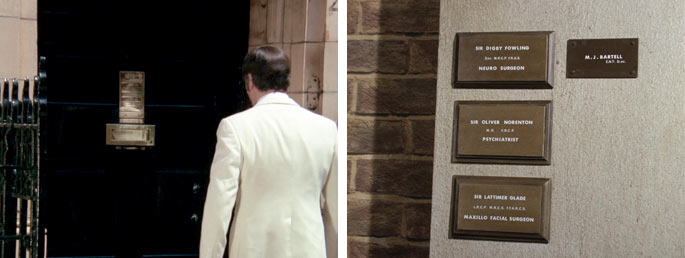 |
|
Images ©
ITV Studios, 1969 |
|
-
At 28 minutes and 7 seconds, we
see that Jean's desk is placed so that there is just
enough room for one person to stand beside it. When
Inspector Large arrives 29 seconds later, the desk
has moved to the far corner of the room, and Jean
with it!
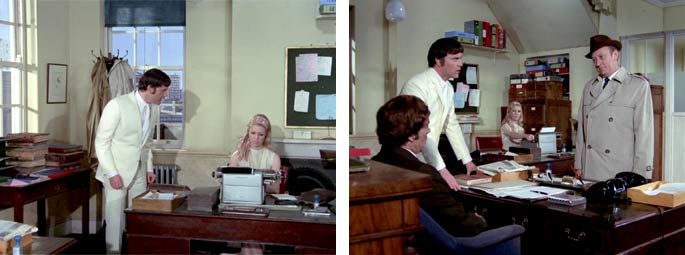 |
|
Images ©
ITV Studios, 1969 |
|
- At 45 minutes and 10
seconds, Inspector Large tells Laker that "We'll be
right over". When Laker informs his confederates
about the call, he says that Large was "Very
helpful. Said he'd be here in about 20 minutes."
-
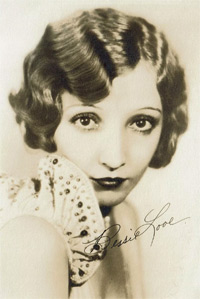 And Finally...
Viewers can be forgiven for actor spotting while watching episodes of Randall and Hopkirk
(Deceased) and other ITC series. Every episode is populated with
familiar faces belonging to people who pop up in any
number of films and television shows from the era
and beyond. However, there is one of the series'
supporting actors who is considerably less well
known to later generation audience members, but who
was a such a star in her day that in 1960 she was
awarded with a Star on the Hollywood Walk of Fame in
Los Angeles. The person in question is Bessie Love,
who played Mrs. Trotter, one of Sir Oliver's
patients in When Did You Start To Stop Seeing Things? Born Juanita Horton in Midland, Texas,
in 1898, Bessie gained ingenue parts from 1915 when
the pioneering film director placed her under an
exclusive contract with his Fine Arts company. Her
work with the company placed her in the spotlight
but a couple of ill-advised moves to work for other
companies meant that her career as a dramatic
actress didn't really blossom until the early 1920s.
The coming of sound witnessed her star rising in
1929 and 1930 with an inspired move into musical
comedy. In 1935, she moved to England, where she
continued to work in film, on stage and, eventually,
on television, occasionally returning home to work
there too. And Finally...
Viewers can be forgiven for actor spotting while watching episodes of Randall and Hopkirk
(Deceased) and other ITC series. Every episode is populated with
familiar faces belonging to people who pop up in any
number of films and television shows from the era
and beyond. However, there is one of the series'
supporting actors who is considerably less well
known to later generation audience members, but who
was a such a star in her day that in 1960 she was
awarded with a Star on the Hollywood Walk of Fame in
Los Angeles. The person in question is Bessie Love,
who played Mrs. Trotter, one of Sir Oliver's
patients in When Did You Start To Stop Seeing Things? Born Juanita Horton in Midland, Texas,
in 1898, Bessie gained ingenue parts from 1915 when
the pioneering film director placed her under an
exclusive contract with his Fine Arts company. Her
work with the company placed her in the spotlight
but a couple of ill-advised moves to work for other
companies meant that her career as a dramatic
actress didn't really blossom until the early 1920s.
The coming of sound witnessed her star rising in
1929 and 1930 with an inspired move into musical
comedy. In 1935, she moved to England, where she
continued to work in film, on stage and, eventually,
on television, occasionally returning home to work
there too.
You can read more about
Bessie Love in our
Who's Who? section.
Plotline: Scoton Productions / ITC UK
Transmissions by Simon Coward and Alan Hayes
Review by Alan Hayes Declassified by
Alan Hayes
with thanks to Simon Coward, Vince Cox, Alys Hayes, John
Holburn,
Anthony McKay and Andrew Pixley
All timings given on this page relate to the Blu-ray editions of this episode |
|
Back to
Programmes Index
Forward to
Just for the Record
Locations: When Did You Start To Stop Seeing Things?
|
|
|
Back to Top |
|



